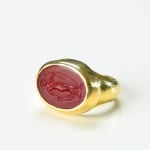Classical Revival Intaglio of a Female Deity, 1700 CE - 1900 CE
Carnelian-Gold
FJ.6083
This intaglio is set in a modern 18 karat gold ring The art of glyptics, or carving on colored precious stones, is probably one of the oldest known to humanity....
This intaglio is set in a modern 18 karat gold ring
The art of glyptics, or carving on colored precious stones, is probably one of the oldest known to humanity. Intaglios, gems with an incised design, were made as early as the fourth and third millennia BC in Mesopotamia and the Aegean Islands. They display a virtuosity of execution that suggests an old and stable tradition rooted in the earliest centuries. The tools required for carving gems were simple: a wheel with a belt-drive, a set of drills, and abrasives, absolutely necessary since the minerals used were too hard for a metal edge to leave as much as a scratch on them. A special difficulty of engraving intaglios, aside from their miniature size, was that the master had to work with a mirror-image in mind.
The wealthy and noble classes of the 18th.Century adored mythological scenes, especially those showing men and women with beautiful bodies. The Greek gods were noted for such glorious physiques, and it is no surprise the goddess of love should be the most lithe and gracious. The lovely woman on this intaglio may be Aphrodite, or perhaps Artemis just emerging from a dip in a secluded pool. Her right foot is just below the surface line as if there is water below, and she holds the gracefully curved robe about to dry herself. The elegance of this ring epitomizes an age still admired for its style; as refined as the person who chooses to wear something so distinctive.
The art of glyptics, or carving on colored precious stones, is probably one of the oldest known to humanity. Intaglios, gems with an incised design, were made as early as the fourth and third millennia BC in Mesopotamia and the Aegean Islands. They display a virtuosity of execution that suggests an old and stable tradition rooted in the earliest centuries. The tools required for carving gems were simple: a wheel with a belt-drive, a set of drills, and abrasives, absolutely necessary since the minerals used were too hard for a metal edge to leave as much as a scratch on them. A special difficulty of engraving intaglios, aside from their miniature size, was that the master had to work with a mirror-image in mind.
The wealthy and noble classes of the 18th.Century adored mythological scenes, especially those showing men and women with beautiful bodies. The Greek gods were noted for such glorious physiques, and it is no surprise the goddess of love should be the most lithe and gracious. The lovely woman on this intaglio may be Aphrodite, or perhaps Artemis just emerging from a dip in a secluded pool. Her right foot is just below the surface line as if there is water below, and she holds the gracefully curved robe about to dry herself. The elegance of this ring epitomizes an age still admired for its style; as refined as the person who chooses to wear something so distinctive.



